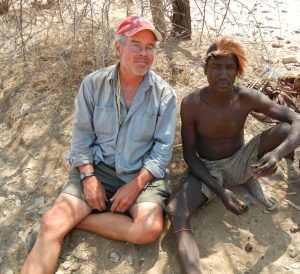Henry Bunn
Position title: Glynn LL Isaac Professor of African Paleoanthropology
Email: htbunn@wisc.edu
Phone: 608-263-6854
Address:
5448 Sewell Social Science Building

Links
Affiliations
African Indian Studies Program
Areas of Focus
Archaeology of human origins, Evolution of human diet and foraging strategies, East Africa
Research
My research emphasizes the evolutionary ecology of Early Pleistocene hominins, particularly the diet and foraging strategies of early Homo, and the behavioral ecology and archaeology of Hadza foragers near Lake Eyasi in northern Tanzania. For many years, I participated in paleoanthropological field research at Koobi Fora, and for the past ten years, I have conducted annual excavations of Oldowan archaeological sites at Olduvai Gorge with other international researchers and students. I conducted the first comprehensive taphonomic analysis of fossil bone assemblages from Early Pleistocene archaeological sites at Olduvai and Koobi Fora, documenting the (then) oldest known butchery marks and recognizing their significance in demonstrating hominin involvement in meat-eating and in the formation of the sites. To provide insights about some of the dynamics of a hunting and gathering way of life and its archaeological signatures, I have conducted long-term field studies of several foraging societies, including the Kua San in Botswana and the Hadzabe in Tanzania (starting in 1984 and ongoing). My current research prioritizes the study of age-at-death, or mortality patterns of prey animals from their teeth to understand how such evidence contributes to reconstructions of the evolution of hunting.
Teaching
My favorite courses to teach annually include:
- a paleoanthropology survey course combining hominin fossil and archaeological evidence from the Pliocene and the Pleistocene;
- a hands-on laboratory course in zooarchaeology on the identification and analysis of mammal bones from archaeological sites;
- early African prehistory and evolution.
Select Publications
- Bunn, H.T., Gurtov, A.N. (2014) Prey mortality profiles indicate that Early Pleistocene Homo at Olduvai was an ambush predator. Quaternary International 322-323, 44-53.
- Bunn, H.T., et al. (2010) Was FLK North levels 1-2 a classic ‘living floor” of Oldowan hominins or a taphonomically complex palimpsest dominated by large carnivore feeding behavior? Quaternary Research 74, 355-36.
- Bunn, H.T., Pickering, T.R. (2010) Bovid mortality profiles in paleoecological context falsify hypotheses of endurance running hunting and passive scavenging by early Pleistocene hominins. Quaternary Research 74, 395-404.
- Bunn, H. T. (2007) Meat Made Us Human. In Evolution of the Human Diet, edited by P. Ungar. Oxford University Press, Oxford.
- Stanford, C., and H. T. Bunn, editors (2001) Meat-Eating and Human Evolution. Oxford University Press, Oxford.
- Bunn, H. T., and E. M. Kroll (1986) Systematic Butchery by Plio-Pleistocene Hominids at Olduvai Gorge, Tanzania. Current Anthropology 27(5):431-442.